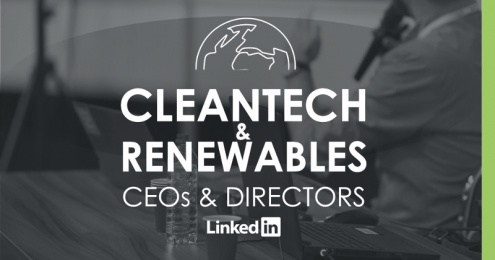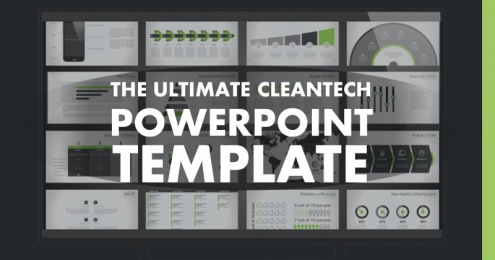7 Winning Content Marketing Strategies for Cleantech and Renewables in 2023
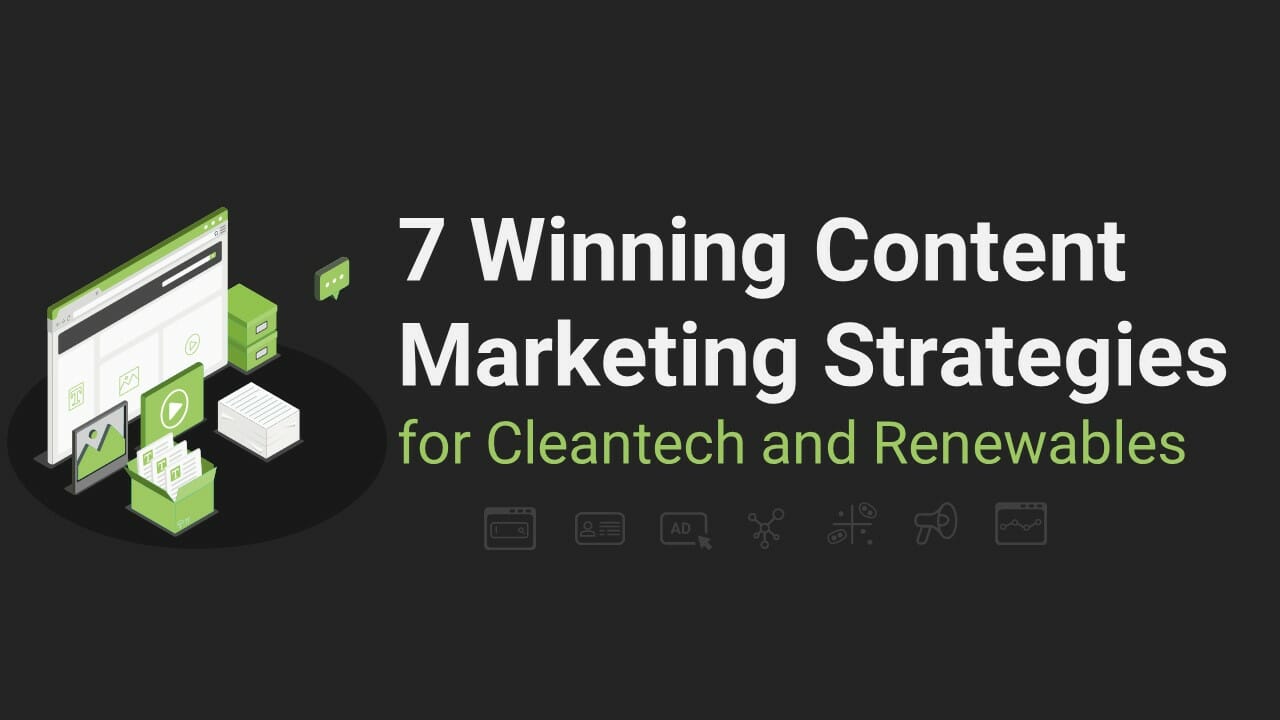
Content marketing is not just a powerful growth tool for technical businesses – it is also a “force multiplier“. In strategy terms, this means it gives all other marketing efforts a boost in effectiveness beyond their original capability.
There are five main ways to get traffic to your website: paid ads, organic traffic (SEO), email, social media, and inbound links. Content marketing can boost all of these in different ways.
Content marketing can also generate three times as many leads than traditional marketing while costing 62% less 1. To add to that, it also costs less in the long run than running ads.
Let’s examine these different content marketing strategies as well as how to apply them!
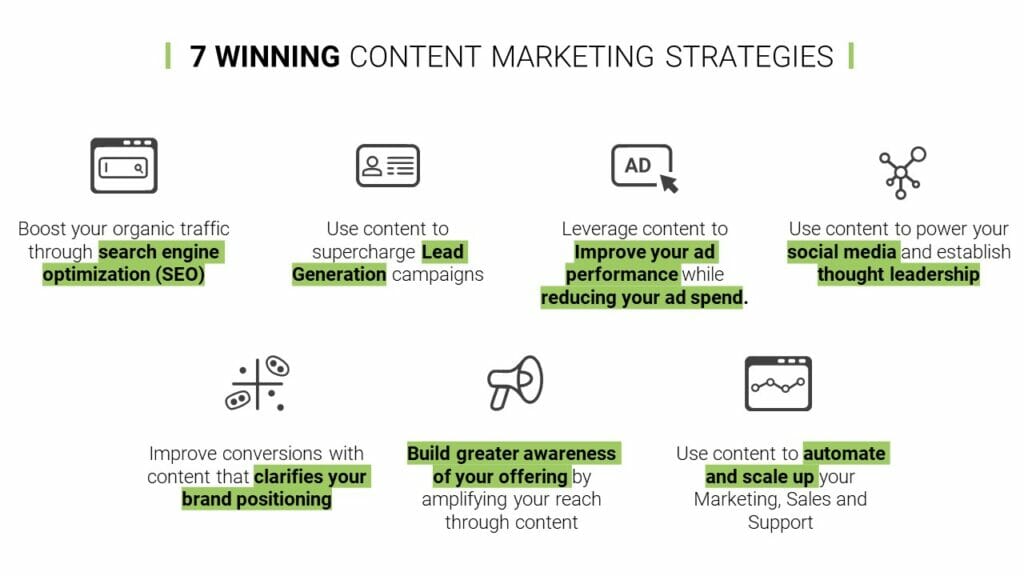
Table of Contents
- 1) Boost your organic traffic through search engine optimization (SEO)
- 2) Generate Leads
- 3) Improve your ad performance while reducing your ad spend.
- 4) Establish thought leadership
- 5) Reposition your brand
- 6) Build greater awareness of your cleantech offering
- 7) Use content to scale up your Marketing, Sales and Support
- A final note on content marketing for cleantech
- Sources
1) Boost your organic traffic through search engine optimization (SEO)
SEO leads have a higher close rate than leads from other sources 2. SEO also provides 10x more traffic than organic social media 3. Yet content in cleantech is often geared towards social media and not always optimized for SEO. Surprisingly, 91% of content gets no traffic from Google 4. This presents a huge opportunity to those who start optimizing their content for SEO.
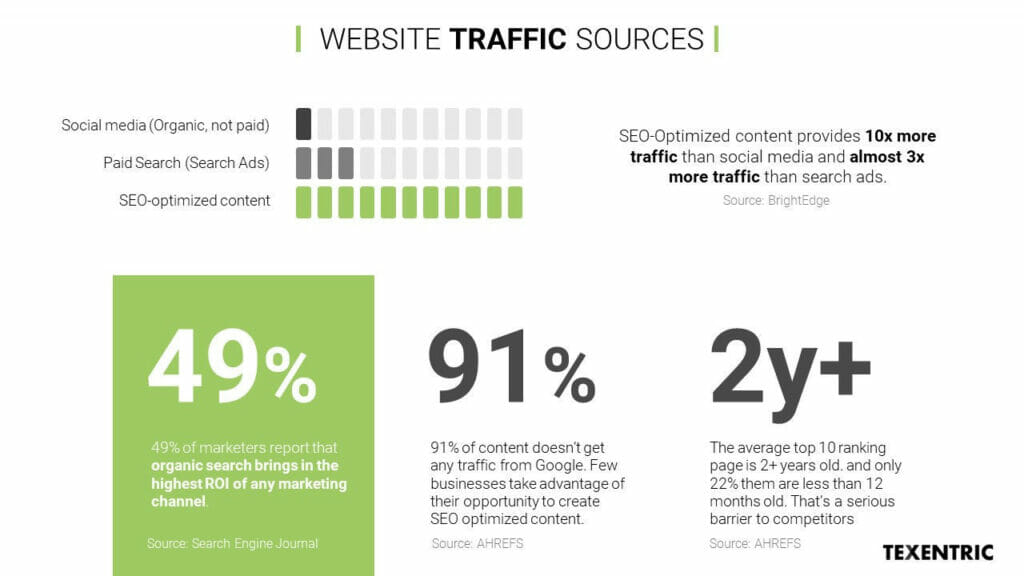
Google’s “E-A-T” guidelines (expertise, authority, and trustworthiness) require that you publish content that demonstrates expertise in your area (subject matter expertise), authority (other people and sites recognize your expertise – typically with backlinks) and trustworthiness (your site is established and secure). Highly-relevant content of excellent quality will cover the expertise requirement. Great content that gets shared and creates links to your site covers the authority requirement.
Search engines also reward sites that provide prolific, in-depth, content around a specific topic. For solar marketing, this could mean the content covers a wide range of subtopics relevant to the specific topic of solar PV.
Panel technologies, mounting systems, panel tiers, system sizing, subsidies, energy storage, installation procedures, maintenance, inverters, EV charge ports and heat pumps are all relevant topics. Producing abundant and thorough content on all of these subtopics will reward this site with traffic by search engines, as they consider it a “topical authority.”
Topical authority is very potent – sites that have reached a high topical authority status can even outrank others that have higher Domain Rating (DR) that have more backlinks. However, without proper research and content planning, topical authority is just a pipe dream. And to achieve all of this, your content must be SEO-optimized so that it is findable in the first place.
Here’s what to do to to drive organic traffic with SEO:
Conduct thorough keyword research. Check to see how competitive you can be for the keywords you want to target as well as how much traffic they can actually produce.
Offer valuable content. Don’t prioritize optimization over value. Make sure that your audience gets something of real, relevant value from your content. Make people want to come back for more!
Build a topical map. Don’t write on just any subject, make all topics relevant to your keywords. Build a list of topics based on the keywords that you want to rank for. These should be closely related to the key topic you want to rank for. Make sure your content answers common questions that your buyers have. Produce high-value content that covers these topics individually.
All content can be SEO-optimized, even if it is only for social media use, as your posts can actually rank in search results. SEO-optimized content placed on social platforms like Linkedin or Medium can often rank at the top of the Search Engine Results Pages (SERPs). You’ll need to be careful not to cannibalize your rankings through this social content and to make sure it results in readers taking some sort of action.
Have a long-term focus and publish on a regular basis. SEO content can typically take between 2 and 6 months to start ranking, and you need to be persistent. Consider the fact that the average top 10 ranking page is 2+ years old, and only 22% of pages that currently rank in the top 10 are less than 12 months old 5. The benefit is that SEO is a long-term strategy that can offer some protection against competitors.
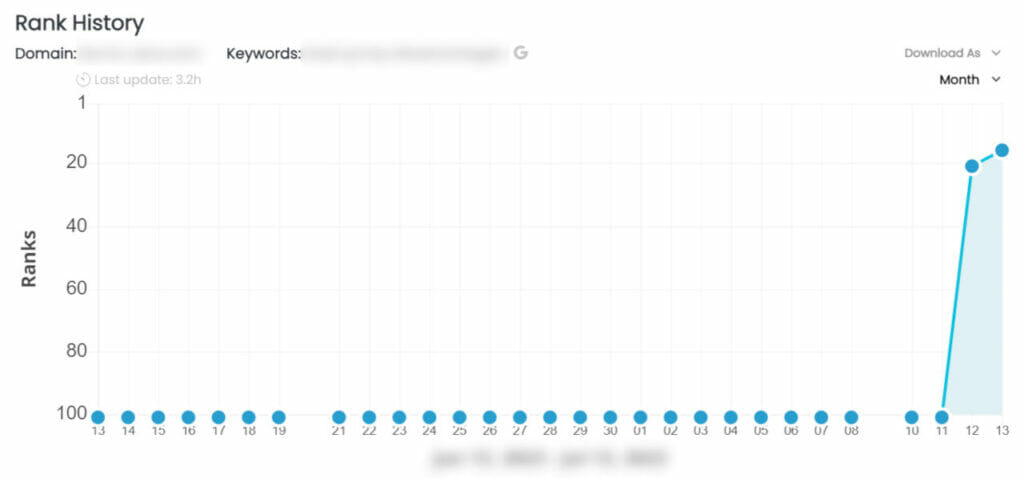
Getting started doesn’t take very long with initial rankings showing up within a couple of months. You will still need to dedicate persistent efforts to move up and dominate the first page ranks though.
Optimize for your local market. If you’re an EPC, especially if you are a solar PV or heat pump installer, your content SEO optimizations must include location terms. This can get very competitive in some regions, but those leading in rankings are always committed to their SEO-optimized content strategy.
| Metrics / Tools | Details |
| Keyword rankings | Use rank tracking software to provide you with your rankings for each of your target keywords. Ideally a weekly report on how these change over time. |
| Analytics | Which pages / posts get most organic traffic? Traffic overview, track your monthly users, pageviews, and sources: where do you get your traffic from? For what content does a high bounce rate indicate low engagement? |
| Backlinks and Domain Rating / Authority | What is your site’s DR score? How many backlinks do you have? Which content gets linked to most? At what rate are backlinks growing and from which initiatives? |
| Google Search Console | Track your monthly impressions, clicks and click-through-rate (CTR). Which search terms drive most traffic to your website? Which terms have the highest impression to click ratio (these probably need fixing!). |
| Page Speed Insights | What are your site’s scores for performance, accessibility, best practices and SEO? If your site has a really poor score it will probably tank your efforts. |
2) Generate Leads
As I previously mentioned, content marketing can generate three times as many leads than traditional marketing approaches.
Cleantech solutions are almost always technical, high-involvement purchases, so content is ideal to capture leads.
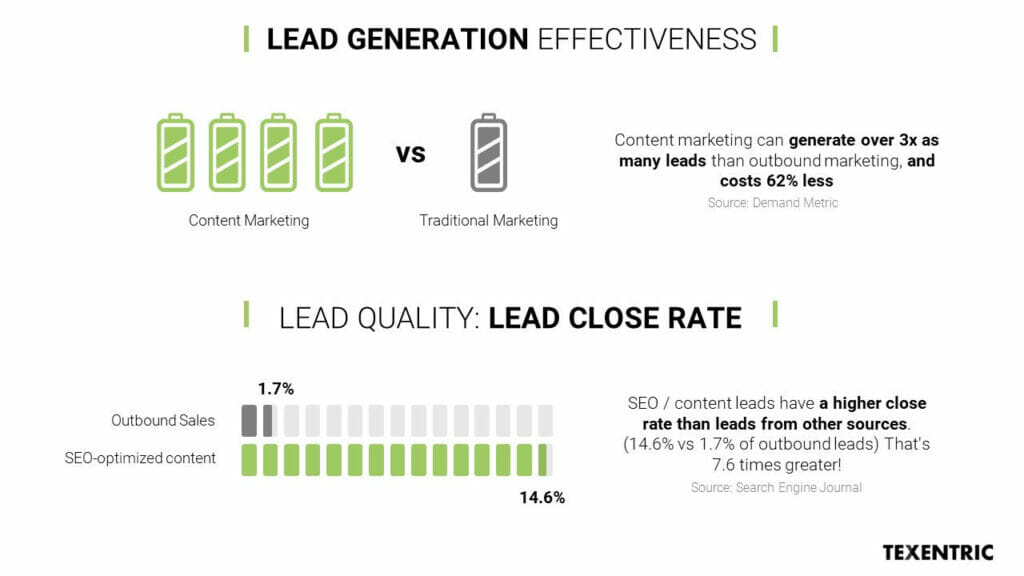
Content is best used to generate awareness and interest at the top of the sales funnel (ToFu) compared to the bottom of the funnel (BoFu). In cleantech, renewables – and solar in particular – where sales cycles are longer, buyers immerse themselves in research prior to reaching out to potential installers.
Your relationship with customers starts much sooner than the sales call. That’s why it’s important to produce ToFu content and capture leads early on to take advantage of the opportunity to nurture them.
You can use BoFu content to augment ToFu content in nurturing captured leads. Don’t only rely on BoFu content to draw in buyers that are closer to the purchase though, as this isn’t a very effective approach without the nurturing.
Here’s what to do to to capture leads with content marketing:
To capture leads with content marketing you need:
- High-quality, valuable content (just like this!) to capture the attention of your target buyers.
- Conversion-optimized landing pages with an irresistible call to action.
- A valuable, relevant lead magnet (a free guide, consultation, webinar, etc).
- A compliant lead capture form that is linked to your marketing automation system and CRM.
- Distribution for your content (your email database, social media following, inbound traffic etc).
- Agreed lead scoring rules – define what a sales-qualified lead looks like to manage the relationship.
- A nurturing sequence – you’ll need more valuable content for each step of the buyer’s journey.
- Sales followup – shockingly, only 20% of sales leads are followed up, so establish a 100% followup rule. This figure may have to do with poor prequalification so it’s important to know firsthand whether qualification or followup is at fault.
| Metrics / Tools | Details |
| Leads captured | Keep a tab on the count of leads captured every week. |
| Customer Aquisition Cost (CAC) | Knowing how much it costs to attract a new client will help you make better decisions and keep costs under control. |
| Customer Lifetime Value (LTV) | Calculate the value of your clients over their lifetime. This should be significantly higher than your CAC. |
| Return on Investment (ROI) | Track the return you get on your lead gen efforts. |
| Lead source / UTM code breakdown | Knowing which campaign or piece of content you get your leads from will help you make better content planning decisions. |
| Cost per lead (CPL) | Track the cost per lead acquired. |
| Lead Conversion Rate | This is the ratio of leads generated to landing page visitors. |
| Lead Value | Each lead has a value attached to it based on the size of the opportunity. Lead Value stats can help identify if there are segments with different values but can also be combined with the Lead Source to identify which content brings in the leads of the highest value. |
| Lead to Sale Conversion Rate | This is the ratio of sales generated to leads generated. |
| Lead scoring metrics (MQL:SQL) | Comparing the ratio of marketing qualified leads to sales qualified leads will show us if there is a large discrepancy between the two, which could indicate lead quality issues. |
| Segment / Qualification / Scoring Breakdown. | A breakdown of leads by qualification status, segment or lead score will give you insights into the quality of your leads. |
| Log: Discarded leads | Keeping track of poor quality leads that don’t qualify for a sale is an important step to improving lead quality. Understanding why they are unsuitable can help you tweak your efforts to get better results. An example would be getting a large proportion of leads outside of your geographical market. |
3) Improve your ad performance while reducing your ad spend.
Advertising platforms want to ensure that ads are relevant to the audiences that they serve them to. They look at a bunch of metrics to ensure this, and they reward relevant advertisers with a higher Quality Score as a “relevance bonus”.
If your Google Ads Quality Score is lower than 5, you can end up paying up to 400% more per click compared to the Google benchmark. With a score of 6 or more, your CPC costs can drop by 50% compared to the Google benchmark 6. In addition, with a higher Quality Score you can reach higher ad positions without increasing the bid value. When the clicks add up, so does the impact of your content quality.

When your content is more relevant, your ad click through rate (CTR) will increase as more people engage with the ads. But with the increased click through rate you will also benefit from a discounted CPC, as the Quality Score has improved as a result of the higher CTR.
Google calculates the Quality Score by combining three factors of performance: your expected clickthrough rate (Exp. CTR), your ad relevance – how well your ad matches user search intent (Ad Relevance), and your landing page experience (Landing Page Exp).
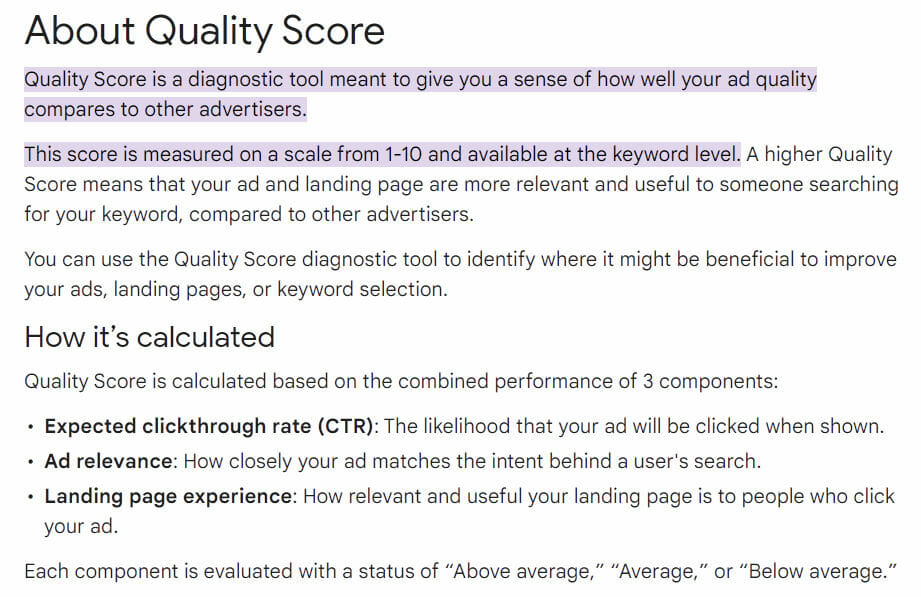
Here’s what to do to to reduce your PPC costs with better content:
As you focus on high quality content, all of this will happen automatically. You just need to align your SEO (landing pages especially) and PPC keywords to make sure that your content is relevant to the ads you run.
Metrics to track:
| Metrics / Tools | Details |
| Cost per acquisition (CPA) | The cost of acquiring a lead or generating a sale. |
| Return on Ad Spend (ROAS) | The amount of revenue generated for every dollar or euro spent on ads. |
| Your Ad Rank | Your ad’s position in the search pages results. |
| Your CPC per ad target keyword | The cost per click you need to pay for each keyword chosen. |
| Your CTR per ad | The percentage of clicks on your ad. |
| Quality Score & Quality Score (hist.) | How well your ad quality compares to other advertisers. It’s a combined measure of the three metrics below. |
| Landing Page Exper. & Landing Page Exper. (hist.) | Whether people bounce off your ad’s landing page or not. Compare your current landing page experience score to past values. |
| Ad Relevance & Ad Relevance (hist.) | An estimation of the relevance between your ad and the searching user’s intent. Compare to past figures. |
| Exp. CTR. & Exp. CTR. (hist.) | An estimation of whether your ad will be clicked on when displayed. Compare to past figures. |
4) Establish thought leadership
Thought leadership for yourself or any of your CxOs or directors is simply a product of content and distribution.
Whether you’ve written a book, have your own podcast or YouTube channel, blog, speak at events or are very active on social media – success comes down to the relevance and value of your content as well as the power of your content distribution.
If you’re producing great content, you’re already halfway there. The content must be focused on your cleantech expertise, and must be original. Adding character and authenticity helps make the message resonate more.
The second element to establishing thought leadership is to increase your reach. This is where owned email lists and social media reach come into play and are very important. It takes time to build a following, but there are tools and ways to expedite this on most social media platforms.
Here’s what to do to to start establishing though leadership through content:
- Define and clarify your niche audience – e.g:“I’m an IoT startup partner talking about how to build partnerships in the IoT space.“
- Pick your voice, tone, style and content proposition.
- Set a content calendar for the next 12 months (or use your existing content calendar!).
- Fix a posting schedule that is easy for you to stick to and be consistent. Post scheduling and automation are important and will make your life easier.
- Pick your medium, optimize it and grow your audience.
- Create, curate and engage consistently and focus on bringing value to your niche’s interests.
- Switch it up – you can expand your audience through various media, speaking engagements, channels, collaborations, guest posts, etc.
- Build a go-to list of talking points that relate to your offering (and include a call to action when possible).
Metrics:
| Metrics / Tools | Details |
| Social Media Engagement Metrics | Comments, likes, questions, reactions. Often these are referred to as vanity metrics (which they indeed are if they are the only metrics that you track). |
| Reach | Followers, reshares, reposts, retweets and so on will show you how far your messages can reach. |
| Site traffic, Backlinks | Analytics can shine some light on whether your efforts are translating into commercial goals. |
| Time on Page | Is your content interesting or shallow? Are visitors bouncing? |
| Actions taken | Tracking hard metrics such as sales, subscriptions, downloads, etc. can be a more pragmatic approach to just vanity metrics. |
| Press Mentions | Brand and expert name mentions, industry publication mentions, stories picked up, press inquiries. |
| Cache metrics | How well are you doing with invitations to speaking engagements? Are you in the top rankings in industry lists published by the press? |
| Leads, partnership opportunities, valuable connections. | These metrics can be more substantial in tracking your success in thought leadership through content. |
5) Reposition your brand
Are you finding it hard to explain how your business stands out? Are prospects missing the value in your offering? Perhaps people don’t understand what your brand / solution is all about.
Unless you are positioning your business as a low-cost provider (rarely a good idea!) then you’re trying to justify your price on the basis of the additional value you offer. If you’re opting for any kind of differentiation strategy, your content will tell your story far and wide.
“When you produce content you have the opportunity to tell stories that can highlight what you are able to do for your customers.“
If you specialize in custom IoT software for businesses that want to optimize energy usage, you can explain the importance of customization, how it’s done, and the benefits for clients. You can build your reputation as a custom provider as opposed to an out-of-the-box solution provider.
People that interact with your content will understand how your offering is different, superior or more relevant – and many will build a preference for it.
Buyers will always see more value in a provider who they are aware of and whose content they find useful, compared to a competitor they don’t hear from. Case studies and testimonials are part of this process and will help clarify what customers can expect from you.
Here’s how to reposition your brand using content:
- Make sure you start off having your brand’s positioning clearly defined.
- Don’t focus the content on your product or service – focus on your customer’s needs and their experience with you.
- Start by addressing the problems buyers face. Produce content that solves buyer’s concerns and questions in order to keep top of mind.
- Use storytelling to stimulate emotions that will strengthen your brand. Logical arguments are a necessity in B2B and technical product marketing, but also including emotional triggers can supercharge your results.
- Get your customers to tell their story for you. Present case studies from the customer’s perspective – how did their problem get solved through your solution?
- Provide examples as to how your offering is better, easier to use, faster to install, more valuable, has a greater return on investment, is more reliable, etc.
- Tell your brand story. Include small snippets about your business and its background that are relevant to customers and their needs.
- Don’t sell. Content marketing is about providing buyers with value, not spamming people with sales material. Without calling attention to the competition, subtly explain how your offering compares against other offerings.
| Metrics / Tools | Details |
| Qualitative insights, brand association tests, online sentiment tracking, brand perception research, positioning market research. | Market research is typically necessary to track perceptual changes in the mind of customers. Performed over time, you can see how attitudes towards your brand change. Interviews and focus groups are often a necessity in keeping track of your positioning. |
| Customer satisfaction levels, Net Promoter Score, online ratings, product / service reviews, customer loyalty. | These tools will help track customer satisfaction in different ways. Improved positioning can be confirmed by examining the feedback customers provide. |
| Market share changes, brand equity index. | These metrics are the result of better positioning in the long-term. However, the other metrics mentioned can confirm you’re on the right track faster. |
| Content A/B tests for conversion | One of the fastest ways to test certain aspects of positioning is to run multiple A/B tests on copy to see which perform better. Winning copy can help you communicate a better positioning approach. You will need a decent sample size to run multiple tests accurately though. |
6) Build greater awareness of your cleantech offering
If your solution is valuable to buyers, then they need to hear about it. And since buyers aren’t necessarily looking for your solution, you need to talk about their problems instead.
For many cleantech technologies, you can’t rely on high purchase intent searches. If, for instance, your renewable energy technology is new and disruptive, people won’t be aware of it yet in order to look it up. This means any successful marketing approach will need to include an educational component.
SEO-optimized content can play a crucial role in capturing an audience searching for solutions to their problems and then educating them on your solution’s benefits. Building awareness of what you offer and how it relates to buyer pains is a crucial step towards getting clients to adopt it.
Here’s how to build awareness of your disruptive offering:
- Create a topical map of content that addresses common buyer pains, needs and questions.
- Produce frequent, valuable content on topics that address buyer concerns and questions.
- Create content that attracts industry press coverage – major surveys, interesting analysis, white papers etc.
- Simplify and clarify: try to keep your messages simple and easy to understand.
- Expand your reach starting with your social media following – this will help amplify your content distribution. Expand your influence by joining more groups, social media platforms and forums where your prospects are.
- Build your email list through popup prompts, free gated content and subscription drives
- Your educational talking points should mention the unique advantages of the technology but focus on the uniqueness of the benefits for customers.
- Reword and repeat: repetition aids learning, so repurpose content to get the most value out of it.
| Metrics / Tools | Details |
| Reach | A healthy growth in your brand awareness requires a steady growth in your reach. Keep a tab on your social media reach, email list size and their growth rate too. |
| Search volume for brand keywords | The trend in search volume for your brand name can also help understand how your brand awareness is developing. |
| Media mentions | Track your brand in the press and keep a tally on media mentions, interviews, articles and so on. |
| Website traffic | Website traffic is one of the more pragmatic indicators of awareness as it looks at people who have an active interest in your product. You can also keep a check on referral traffic too. |
| Brand recognition and recall | Conducting market research on brand recognition and recall may be a bit extreme for cleantech and renewables but can it be of some value in certain situations. |
| Share of voice | Share of voice refers to a series of metrics that track your brand’s visibility as a share of total visibility in the market. What is your ad spend compared to the total ad spend in your market? What is your share of social media posts in your niche? What is your share of impressions in SEO for the keywords you are competing for? These metrics track inputs mostly. They are also a measure of volume, not quality. However, they can be helpful in deciding how to spend your marketing budget best, if they take into account outputs such as sales etc. |
| Impressions | Tracking your content impressions can help you identify your strengths and weaknesses. Topics with more impressions could get more attention in your content planning. |
| Leads, Sales, Profitability | Brand awareness can easily become a vanity metric if it isn’t accompanied by the hard data leads and sales produce. The expression “turnover is vanity and profit is sanity” also applies. Slashing prices to increase sales, awareness and market share doesn’t always work as intended. That’s why as you try to increase awareness you should always keep track of your ultimate goals: leads, sales, profits. |
7) Use content to scale up your Marketing, Sales and Support
Marketing, sales and support time cost money. Content can be used to automate a lot of these processes in order to scale them up faster. Areas where content marketing can help automate are:
Lead generation
Inbound marketing is easier to automate than outbound marketing. Having strong organic website traffic through great content as well as conversion-optimized landing pages is more efficient than outbound sales, cold email or cold calls.
Lead scoring and prequalification
Lead capture forms can be set up to filter leads based on prequalification and scoring criteria. That way, when a lead is flagged for followup in the CRM your sales team can manage their workflow more efficiently.
Lead nurturing (email automations)
Creating a series of emails (a drip campaign) with high-value content reaching your prospects’ emails every week can increase trust, familiarity and credibility. Content can be triggered based on their behavior or based on which stage they are in the buying process.
Pre-sales and customer support
Great content can solve many pre-sales or after-sales questions, reducing the number of tickets your team has to deal with. Having a detailed FAQ section on your site will be a boon for SEO while answering questions and even countering sales objections before they even arise.
For cleantech marketing in particular, having content that clearly explains your sustainable solution automates a lot of the sales process. Any B2B technical product can benefit from strong content marketing really, but cleantech companies that are on the cutting edge of innovation stand to gain a lot.
Client onboarding and training
Good content educates clients so that you don’t have to. You can use content to automate in-person onboarding and training, saving your teams hours or work while making your solutions more accessible to your clients. No tool other than content marketing can provide such a powerful educational element to your marketing.
Social media (content production and scheduling)
Having a good content engine in place also automates a large part of social media. Instead of having to come up with posts of little substance every week you will be producing valuable, shareable content that can be scheduled for automatic posting. Of course this is a long-way from completely automating social media, but it makes things much easier and productive.
Other marketing communications
Content marketing can also be used to manage certain aspects of your other stakeholder communications. Wikis can be set up for internal communications, project management and employee alignment. Investor relations can be simplified with reporting. You can use content marketing to attract new investors and top talent too.
| Metrics / Tools | Details |
| Number of support tickets | Watch the number of tickets drop as you grow your educational and documentation content. |
| Time to resolution | Having set training content, canned response templates and a detailed internal wiki can help reduce the time tickets take to get resolved. The reduced number of tickets should also help support agents clear tickets faster. |
| Customer engagement | The greater engagement is, the faster trust, authority, credibility and awareness are established prior to a sales contact. You can also use most viewed troubleshooting content as a means to improve your product. |
| Product adoption (after education) | Measuring product adoption after education can help you understand how effective your content is in aiding conversion. |
| Changes in churn rates, loyalty, NPS, customer satisfaction, customer feedback scores. | Having quick access to training resources, educational material and use cases can help users onboard and adopt your product faster. It can also reduce stress, resolve problems and increase customer satisfaction. This in turn should reduce your churn rates and increase loyalty. |
| Product roadmap engagement | To improve your product through agile methodologies you need to get customers engaged in the development of your product roadmap. Tracking how many feature requests, upvotes, suggestions, problems and tickets can help you measure whether your content is getting people involved. |
| Additional income from increased upsell / cross-sell | Educating customers on your solution options should increase your upsells and cross-sells as they become aware of the additional benefits offered by these solutions. |
A final note on content marketing for cleantech
OK, so you’re now ready to take advantage of content marketing to grow your clean energy solution. These are powerful strategies and can really get great results. You just need to pay attention to proper research and implementation and make a long-term commitment. Yes, results can take time, but you are also creating a very substantial barrier against competition.
If you need a helping hand, drop me a line. Texentric is a renewables and cleantech marketing agency that specializes in content marketing.
Sources
1 Demand Metric, 2023
2 The Search Engine Journal, 2016
3 Brightedge, 2019
4 AHREFS, 2020
5 AHREFS, 2017
6 Wordstream, 2023
Nicolas Virtsonis, Cleantech Marketer & Founder of Texentric
Nicolas specializes in international marketing for clean technologies. Nick's focus is on international market entry, technology distribution and growth marketing for tech.

